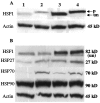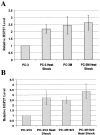A novel association between the human heat shock transcription factor 1 (HSF1) and prostate adenocarcinoma
- PMID: 10702402
- PMCID: PMC1876857
- DOI: 10.1016/S0002-9440(10)64954-1
A novel association between the human heat shock transcription factor 1 (HSF1) and prostate adenocarcinoma
Abstract
A search for differentially expressed genes in a pair of nonmetastatic (PC-3) versus metastatic variant (PC-3M) human prostate carcinoma cell lines led to identification of the human heat shock factor (HSF1) as an overexpressed gene product in PC-3M cells. Analysis of primary prostate cancer specimens indicated that HSF1 is generally up-regulated in most of the malignant prostate epithelial cells relative to the normal prostate cells. Among the known effectors of HSF1 action, constitutive levels of HSP70 and HSP90 are not significantly altered by the naturally elevated expression of HSF1 as in PC-3M cells or by transduced overexpression of HSF1 in PC-3 cells. The basal levels of HSP27 in both cases are, however, consistently increased by two- to threefold. With respect to response to heat shock, high basal concentration of HSP90 is not further enhanced in these cells, and HSP70 is up-regulated irrespective of HSF1 level. Heat shock, however, causes an increase in HSP27 when HSF1 is up-regulated, except when the expression of HSF1 is already too high. These results document for the first time that HSF1 is overexpressed in human prostate cancer cells, at least one consequence of which in the prostate cancer cell lines tested is stimulation of both basal and stress-induced expression of HSP27, an important factor in cell growth, differentiation, or apoptosis.
Figures







Similar articles
-
Heat shock protein expression independently predicts clinical outcome in prostate cancer.Cancer Res. 2000 Dec 15;60(24):7099-105. Cancer Res. 2000. PMID: 11156417
-
Expression of heat shock proteins and heat shock protein messenger ribonucleic acid in human prostate carcinoma in vitro and in tumors in vivo.Cell Stress Chaperones. 2005 Spring;10(1):46-58. doi: 10.1379/csc-44r.1. Cell Stress Chaperones. 2005. PMID: 15832947 Free PMC article.
-
Transcriptional regulation and binding of heat shock factor 1 and heat shock factor 2 to 32 human heat shock genes during thermal stress and differentiation.Cell Stress Chaperones. 2004 Mar;9(1):21-8. doi: 10.1379/481.1. Cell Stress Chaperones. 2004. PMID: 15270074 Free PMC article.
-
Heat shock proteins and heat shock factor 1 in carcinogenesis and tumor development: an update.Arch Toxicol. 2013 Jan;87(1):19-48. doi: 10.1007/s00204-012-0918-z. Epub 2012 Aug 11. Arch Toxicol. 2013. PMID: 22885793 Free PMC article. Review.
-
Size doesn't matter in the heat shock response.Curr Genet. 2017 May;63(2):175-178. doi: 10.1007/s00294-016-0638-7. Epub 2016 Aug 8. Curr Genet. 2017. PMID: 27502399 Free PMC article. Review.
Cited by
-
The Interplay between Heat Shock Proteins and Cancer Pathogenesis: A Novel Strategy for Cancer Therapeutics.Cancers (Basel). 2024 Feb 1;16(3):638. doi: 10.3390/cancers16030638. Cancers (Basel). 2024. PMID: 38339390 Free PMC article. Review.
-
Defects in death-inducing signalling complex formation prevent JNK activation and Fas-mediated apoptosis in DU 145 prostate carcinoma cells.Br J Cancer. 2003 Nov 17;89(10):1950-7. doi: 10.1038/sj.bjc.6601393. Br J Cancer. 2003. PMID: 14612908 Free PMC article.
-
Heat shock proteins in cancer: diagnostic, prognostic, predictive, and treatment implications.Cell Stress Chaperones. 2005 Summer;10(2):86-103. doi: 10.1379/csc-99r.1. Cell Stress Chaperones. 2005. PMID: 16038406 Free PMC article. Review.
-
Heat-shock proteins in infection-mediated inflammation-induced tumorigenesis.J Hematol Oncol. 2009 Jan 30;2:5. doi: 10.1186/1756-8722-2-5. J Hematol Oncol. 2009. PMID: 19183457 Free PMC article. Review.
-
Gene expression profiling of mouse bladder inflammatory responses to LPS, substance P, and antigen-stimulation.Am J Pathol. 2002 Jun;160(6):2095-110. doi: 10.1016/S0002-9440(10)61159-5. Am J Pathol. 2002. PMID: 12057914 Free PMC article.
References
-
- Sarge KD, Zimarino V, Holm K, Wu C, Morimoto RI: Cloning and characterization of two mouse heat shock factors with distinct inducible and constitutive DNA-binding ability. Genes Dev 1991, 5:1902-1911 - PubMed
-
- Wu C: Heat shock transcription factors: structure and regulation. Ann Rev Cell Dev Biol 1995, 11:441-469 - PubMed
Publication types
MeSH terms
Substances
Grants and funding
LinkOut - more resources
Full Text Sources
Other Literature Sources
Medical
Research Materials
Miscellaneous

